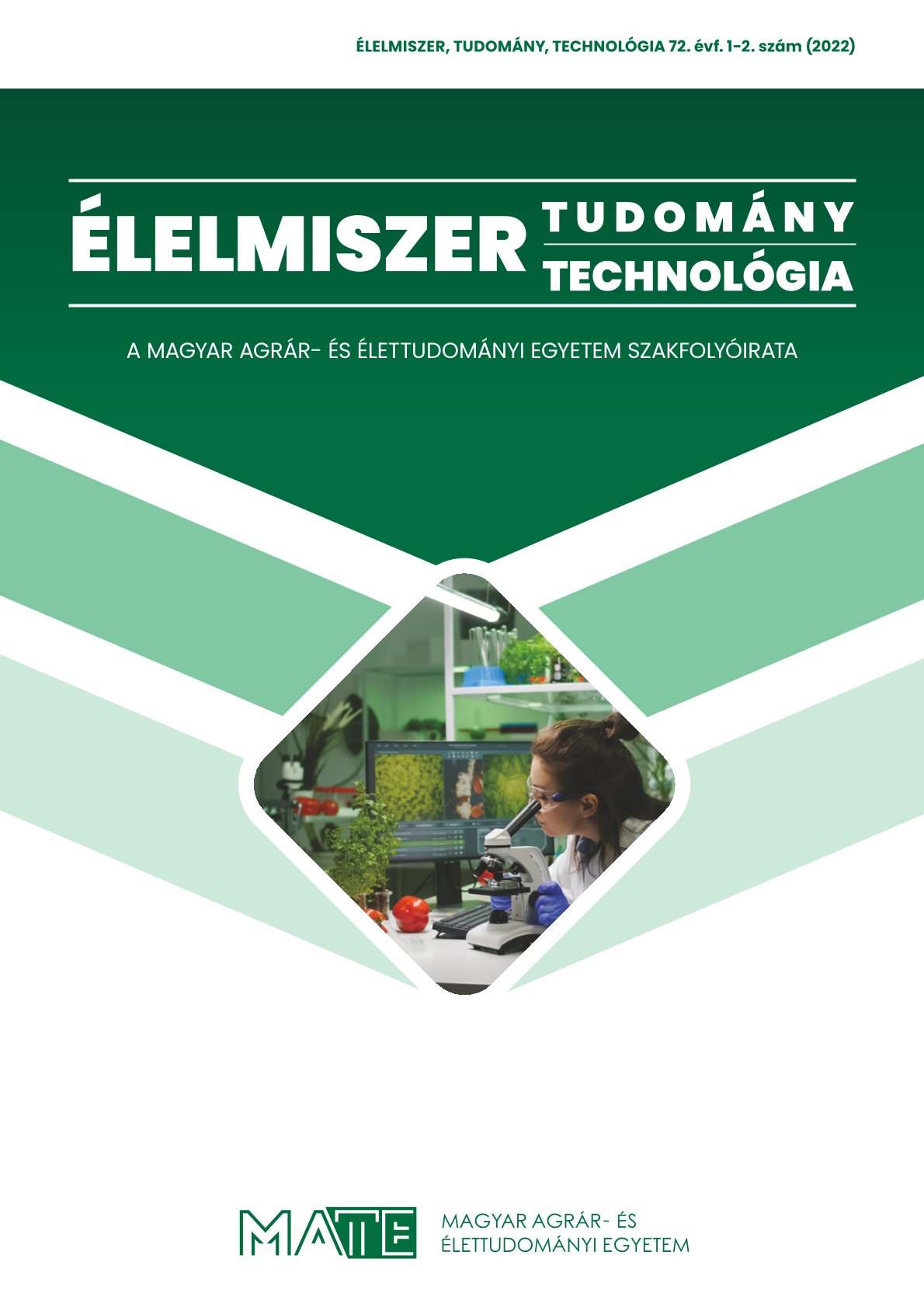Fehérje- és DNS-kimutatáson alapuló állatfajspecifikus vizsgálati eljárások áttekintése
Kulcsszavak:
állatfaj azonosítás, fehérje kimutatás, DNS kimutatásAbsztrakt
A húsok és hústermékek vizsgálatában az élelmiszer-biztonság és a minőségbiztosítás szempontjait figyelembe véve fontos lehet az állatfajok azonosítása, és az idegen fehérjék (növényi és nem-hús eredetű állati fehérjék) kimutatása. Az eredetvizsgálat műszeres megközelítését indokolja, hogy darált húsok, fagyasztott tömbhúsok, különféle hústermékek esetén a fajok érzékszervileg sokszor már nem azonosíthatók. A gazdasági okok mellett a húsok azonosításának egészségi, vallási és állatvédelmi szempontból is nagy a jelentősége. A húsok faj-specifikus eredetének meghatározására az élelmiszeranalitikai eljárások széles skálája alkalmazható, mely módszerek leggyakrabban a fehérjék vagy a DNS vizsgálatán alapulnak, cikkünkben ezeket tekintjük át.
Hivatkozások
Ballin, N.Z., Vogensen, F.K., Karlsson, A.H. (2009): Species determination – Can we detect and quantify meat adulteration? Meat Science, 83:165–174. https://doi.org/10.1016/j.meatsci.2009.06.003
Cao, Y., Zheng, K., Jiang, J., Wu, J., Shi, F., Song, X., Jiang, Y. (2018): A novel method to detect meat adulteration by recombinasepolymerase amplification and SYBR green I. Food Chem., 266:73–78. https://doi.org/10.1016/j.foodchem.2018.05.115
Chen, T.Y., Chen, N.H., Lin, W.F., Hwang, K.L., Huang, Y.C., Hwang, D.F. (2010): Identification of causative fish for a food poisoning in Taiwan by using SDS-PAGE technique. Journal of Marine Science and Technology, 18:593-596. https://doi.org/10.51400/2709-6998.1924
Csehi, B., Szerdahelyi, E., Pásztor-Huszár, K., Salamon, B., Tóth, A., Zeke, I., Jónás, G., Friedrich, L. (2016): Changes of protein profiles in pork and beef meat caused by high hydrostatic pressure treatment. Acta Alimentaria, 45:565-571. https://doi.org/10.1556/066.2016.45.4.14
Ekici, K. (2008): The species identification of raw meat with sds-page technique. Indian Vet. J., 85:1193-1195. Farag, M.R., Imam, T.S., Dhama, K. (2015): Identification of some domestic animal species (camel, buffalo and sheep) by PCR-RFLP analysis of the mitochondrial cytochrome b gene. Adv. Anim. Vet. Sci., 3(2): 136-142. https://doi.org/10.14737/journal.aavs/2015/3.2.136.142
Goodwin, P. (1992): Immunoassay methods for animal specification. 33-39. p. In Morgan M.A., Smoith C.J., Williams P.A. (eds) Food safety and quality assurance: application of immunoassay system. London: Elsevier Sci.Publ.
Griffiths, N.M., Billington, M.J. (1984): Evaluation of an enzyme-linked immunosorbent assay beef blood serum to determine indirectly the apparent beef content of beef joints and model mixtures. Journal of Science of Food and Agriculture, 35:909-914. https://doi.org/10.1002/jsfa.2740350816
Hajós, Gy. (1993): Elektroforézis és alkalmazása az élelmiszerfehérjék elválasztásában. Élelmiszervizsgálati Közlemények, 39:6-26.
Khorana, H.G. (1971): Study on polynucleotides: repair replication of short synthetic DNA’s as catalyzed by DNA polymerases. Journal of Molecular Biology, 56:341.
Kissenkotter, J., Bohlken-Fascher, S., Forrest, M.S., Piepenburg, O., Czerny, C.P., Abd El Wahed, A. (2020): Recombinase polymeraseamplification assays for the identification of pork and horsemeat. Food Chem., 322:126759. https://doi.org/10.1016/j.foodchem.2020.126759
Lungström, I., Engvall, E., Ruitenberg, E.J. (1974): ELISA -Enzyme–linked immunosorbent assay- in serological diagnosisi of Trichinella spiralis infection. In: Proceedings of third international congress of parasitology, Vol I. II. III. Vienna: Facta Publications, 1204-1205.
Mane, B.G., Mendiratta, S.K., Tiwari, A.K. (2009): Polymerase chain reaction assay for identification of chicken in meat and meat products. Food Chem., 116(3):806–810. https://doi.org/10.1016/j.foodchem.2009.03.030
Martin, R., Azcona, J.I., Casas, C., Hernandez, P.E., Sanz, B. (1988a): Sandwich ELISA for detection of pig meat in raw beef using antisera to muscle soluble proteins. Journal of Food Protection, 51:790-794. https://doi.org/10.4315/0362-028x-51.10.790
Martin, R., Azcona, J.I., Casas, C., Hernandez, P.E., Sanz, B. (1988b): A sandwich ELISA for detection of horse meat in raw meat mixtures using antisera to muscle soluble proteins. Meat Science, 22:143-153. https://doi.org/10.1016/0309-1740(88)90088-5
Martin, R., Azcona, J.I., Tirmo, J., Hernandez, P.E., Sanz, B. (1988c): Detection of chicken meat in raw meat mixtures by a sandwich enzyme immunoassay. Int. Journal of Food Science and Technology, 23:303-310. https://doi.org/10.1111/j.1365-2621.1988.tb00584.x
Martin, R., Wardale, R.J., Jones, S.J., Hernandez, P.E., Patterson, R.L.S. (1991): Monoclonal antibody sandwich ELISA for the potential detection of chicken meat in mixtures of raw beef and pork. Meat Science, 30:23-31. https://doi.org/10.1016/0309-1740(91)90031-k
Meyer, R., Höfelein, C., Lüthy, J., Candrian U. (1995): PCRRLFP: A simple method for species identification in food. Journal of AOAC, 78(6):1542-1551. https://doi.org/10.1093/jaoac/78.6.1542
Morales, P., Garcia, T., Gonzales, I., Martin, R., Sanz, B., Hernandez, P.E. (1994): Monoclonal antibody detection of porcine meat. Journal of Food Protection, 54:146-149. https://doi.org/10.4315/0362-028x-57.2.146
Mullis, K.B., Fred, A., Faloona, F.A. (1987): Specific synthesis of DNA in vitro via a polymerase-catalyzed chain reaction. 335-350 p. In: Wu, R. (ed.): Methods in Enzymology. Recombinant DNA. Part F. New York: Elsevier Inc., 628 p. https://doi.org/10.1016/0076-6879(87)55023-6
Rodrigez, M.A., Garcia, T., Gonzales, I., Hernandez, P.E., Martin, R. (2005): TaqMan real-time PCR for the detection and quantitation of pork in meat mixtures. Meat Science, 70:113-120. https://doi.org/10.1016/j.meatsci.2004.12.005
Sawyer, J., Wood, C., Shanahan, D., Gout S., Mcdowell D. (2003): Real-time PCR for quantitative meat species testing. Food Control, 14:579-583. https://doi.org/10.1016/s0956-7135(02)00148-2
Sherikar, A.T., Karkare, U.D., Khot, J.B., Jayaras, B.M., Bhilegaonkar, K.N. (1993): Studies on thermostable antigens production of species-specific antiadrenal sera and comparison of immunological techniques in meat speciation. Meat Science, 33:121-136. https://doi.org/10.1016/0309-1740(93)90099-4
Szántó-Egész, R., Jánosi A., Mohr, A., Szalai, G., Koppányné Szabó, E., Micsinai, A., Sipos, R., Rátky, J., Anton, I., Zsolnai, A. (2016): Breed-specific detection of mangalica meat in food products. Food Anal. Methods., 9:889–894. https://doi.org/10.1007/s12161-015-0261-0
Teletchea F., Maudet C., Hanni C. (2005): Food and forensic molecular identification: update and challenges. Trends in Biotechnology. 23(7):359-366. https://doi.org/10.1016/j.tibtech.2005.05.006
Zhu, P., Gao, W., Huang, H., Jiang, J., Chen, X., Fan, J., Yan, X. (2018): Rapid detection of Vibrio parahaemolyticus in shellfish by real-time recombinase polymerase amplification. Food Analytical Methods. 11(8):2076-2084. https://doi.org/10.1007/s12161-018-1188-z
Letöltések
Megjelent
Folyóirat szám
Rovat
License
Copyright (c) 2022 Jánosi Anna, Koppányné Szabó Erika, Némethné Szerdahelyi Emőke

This work is licensed under a Creative Commons Attribution-NonCommercial-NoDerivatives 4.0 International License.


